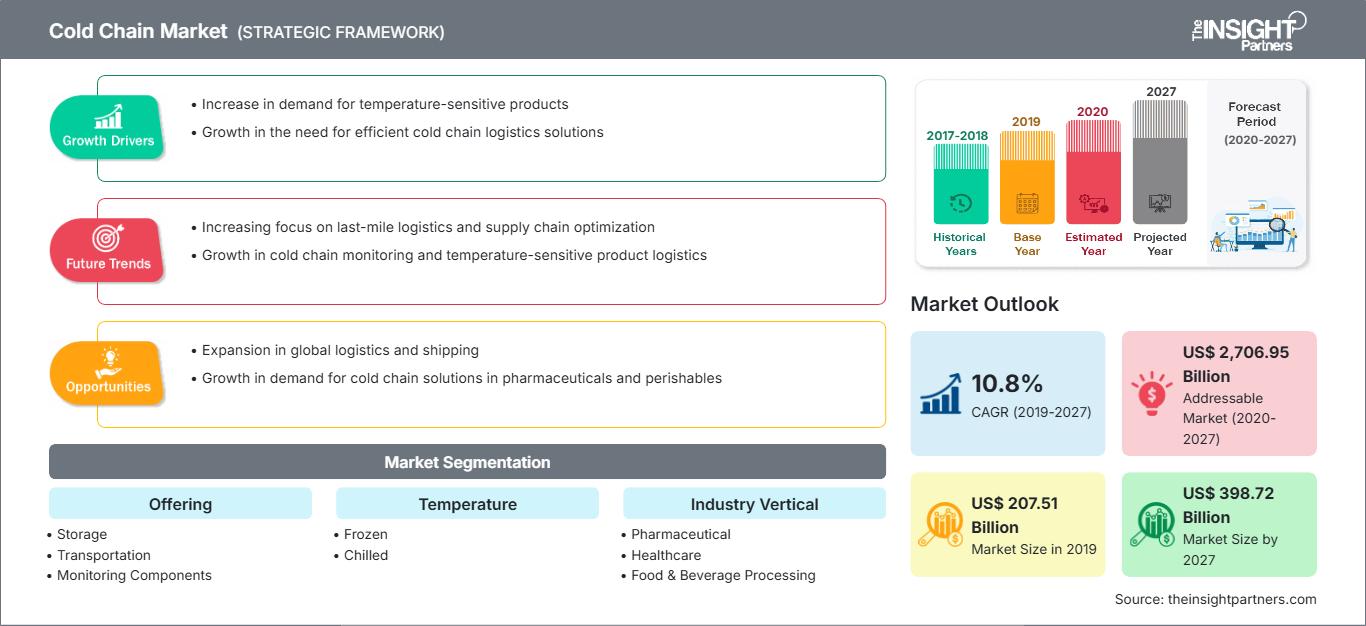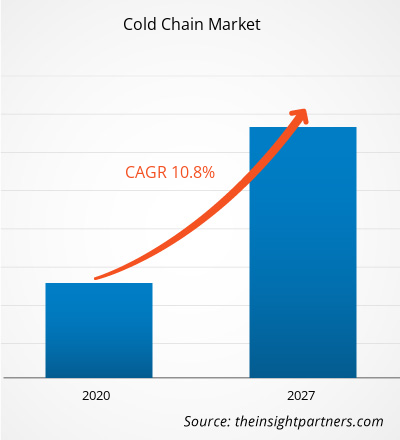En términos de ingresos, el mercado de la cadena de frío se valoró en US$ 207.510,8 millones en 2019 y se proyecta que alcance los US$ 398.723,4 millones para 2027 y se espera que crezca a una CAGR del 10,8% durante el período de pronóstico.
El auge del comercio de productos perecederos y el apoyo gubernamental favorable al desarrollo de la infraestructura de la cadena de frío son los factores clave que se espera impulsen el crecimiento del mercado de la cadena de frío. Las empresas de servicios de cadena de frío también están adoptando tecnologías pioneras para satisfacer la creciente demanda de seguridad alimentaria, en particular la de alimentos procesados. Se prevé que esto ofrezca abundantes oportunidades, impulsando así la proliferación de proveedores multinacionales en el mercado, con la intención de ofrecer soluciones eficientes para la cadena de frío.
Además, se prevé que las estrictas regulaciones de seguridad alimentaria, como la Ley de Modernización de la Seguridad Alimentaria, que exige una mayor atención a la creación de almacenes frigoríficos, impulsen el crecimiento del mercado. Sin embargo, se prevé que los desafíos ambientales, como la emisión de gases de efecto invernadero, obstaculicen el mercado durante el período de pronóstico.
APAC es la segunda región líder en el mercado de la cadena de frío. Se prevé un crecimiento significativo durante el período estimado gracias a la creciente inversión gubernamental en el desarrollo de infraestructura logística y la implementación de sistemas de gestión de almacenes (WMS). China es el principal contribuyente regional y se prevé que registre una tasa de crecimiento anual compuesta (TCAC) considerable durante el período de pronóstico. Se estima que los avances en tecnologías de envasado, procesamiento y almacenamiento de alimentos impulsarán el crecimiento del mercado de la cadena de frío. Asimismo, el rápido crecimiento de la demanda y el desarrollo de la infraestructura de la cadena de frío han convertido al país en un mercado clave. Actualmente, China está experimentando una rápida transición de una economía basada en la manufactura a una economía basada en el consumo.
Obtendrá personalización en cualquier informe, sin cargo, incluidas partes de este informe o análisis a nivel de país, paquete de datos de Excel, así como también grandes ofertas y descuentos para empresas emergentes y universidades.
Mercado de la cadena de frío: perspectivas estratégicas

- Obtenga las principales tendencias clave del mercado de este informe.Esta muestra GRATUITA incluirá análisis de datos, desde tendencias del mercado hasta estimaciones y pronósticos.
Impacto de la pandemia de COVID-19 en el mercado de la cadena de frío
El brote de COVID-19, que comenzó en Wuhan (China) en diciembre de 2019, se ha propagado rápidamente por todo el mundo. El cierre de fábricas, las prohibiciones de viaje y los confinamientos fronterizos para combatir y contener el brote han afectado a todas las industrias y economías del mundo. La mayoría de las plantas de fabricación se encuentran temporalmente cerradas o con un personal mínimo, lo que afecta la cadena de frío y sus componentes. Además, la demanda de alimentos congelados ha disminuido desde el brote de COVID-19 en los países.
Perspectivas del mercado
Aumento de la distribución omnicanal de comestibles en Asia Pacífico
La creciente población asiática está generando un gran interés en alimentos de calidad, tanto nacionales como internacionales. Las importaciones de frutos rojos orgánicos, como fresas y moras, a la región Asia-Pacífico registraron una tasa de crecimiento anual compuesta (TCAC) del 7,5 % entre 2017 y 2019. El desarrollo de la distribución omnicanal está impulsando su creciente utilización. La compra de alimentos en línea aún se encuentra en una etapa incipiente, con menos del 5 % del gasto en alimentos básicos en la mayoría de los mercados de Asia-Pacífico realizado a través de internet en 2019. Esta proporción se basa en el aumento de las entregas rápidas, especialmente en Corea y China. Actualmente, los principales sitios web de entrega de alimentos en línea, como JD.com y Suning.com en China, y Big Basket en India, ofrecen entregas el mismo día o en menos de 24 horas en las principales ciudades.
Perspectivas basadas en ofertas
En términos de oferta, el segmento de almacenamiento captó una participación dominante en el mercado global de la cadena de frío en 2019. Los alimentos y bebidas congelados, los productos químicos, los medicamentos y las materias primas utilizadas en la fabricación de dichos productos deben almacenarse en condiciones de conservación para mantener su calidad. Se deben seguir las recomendaciones de los fabricantes sobre las temperaturas de almacenamiento, lo que implica el uso de instalaciones de almacenamiento especializadas. Se deben utilizar dispositivos de control de temperatura para garantizar el cumplimiento de los rangos de temperatura preferentes. Las buenas prácticas de almacenamiento incluyen el mantenimiento de la temperatura óptima para productos sensibles a la temperatura, según las recomendaciones de los fabricantes. Los equipos de medición y control deben calibrarse y probarse a intervalos definidos. Estos productos deben transportarse de forma que no estén expuestos a temperaturas excesivas de calor o frío, y se deben utilizar medios de transporte especializados siempre que sea necesario.
Información basada en la temperatura
En general, la carga congelada se refiere a productos o alimentos que deben transportarse y almacenarse a la temperatura óptima para protegerlos contra la descomposición y el crecimiento de organismos patógenos. Cierta carga congelada debe transportarse o almacenarse a temperaturas inferiores a -20 °C (-4 °F) para mantener su calidad, textura y sabor. Los productos con alto contenido de grasa, como el helado y el surimi, deben transportarse y almacenarse a -26,1 °C (-15 °F) o menos. Las bajas temperaturas conservan la calidad, el aroma, el sabor, la textura y la apariencia de los alimentos congelados, y los protegen del deterioro.
Perspectivas basadas en verticales de la industria
La cadena de frío para alimentos perecederos generalmente se refiere a la manipulación continua del producto a baja temperatura durante las etapas poscosecha de la cadena de valor, incluyendo la recolección, la cosecha, el procesamiento, el almacenamiento, el empaque, el transporte y la comercialización hasta su llegada al consumidor. Una cadena de frío combinada incluye la gestión del transporte de productos alimenticios perecederos desde la finca, el campo o el cuerpo de agua, a lo largo de toda la cadena poscosecha hasta el consumidor final.
En el mercado de la cadena de frío, las empresas están adoptando diversas estrategias, como el desarrollo de productos, la adquisición y otras estrategias de expansión, para expandir su presencia global y satisfacer la creciente demanda de sus productos. A continuación, se enumeran algunas de las iniciativas recientes en el mercado de la cadena de frío:
2020: Americold Realty Trust anunció su intención de invertir alrededor de 43 millones de dólares en la expansión planificada de su planta de Dalgety en Auckland, Nueva Zelanda.
2020: AmerisourceBergen mejoró su oferta logística al integrar dos de sus negocios: World Courier, proveedor global de logística, e ICS, proveedor externo de logística. Esto ha creado el primer y único socio logístico especializado que ofrece soporte completo desde los ensayos clínicos hasta la comercialización.
2020: Pelican BioThermal inauguró una estación de red en Toronto para dar servicio a su programa de alquiler Credo on Demand. La nueva estación de red se unió al creciente sistema de la compañía, que cuenta con más de 100 estaciones de red y puntos de entrega en todo el mundo. Además de servir como punto de entrega para los clientes de alquiler de Credo On Demand, las estaciones de red dan servicio, reacondicionan, reparan y acondicionan los contenedores reutilizables Credo Cargo y Credo Xtreme de la compañía para su reutilización.
Perspectivas regionales del mercado de la cadena de frío
Los analistas de The Insight Partners han explicado detalladamente las tendencias y los factores regionales que influyen en el mercado de la cadena de frío durante el período de pronóstico. Esta sección también analiza los segmentos y la geografía del mercado de la cadena de frío en Norteamérica, Europa, Asia Pacífico, Oriente Medio y África, y Sudamérica y Centroamérica.
Alcance del informe de mercado de la cadena de frío
| Atributo del informe | Detalles |
|---|---|
| Tamaño del mercado en 2019 | US$ 207.51 mil millones |
| Tamaño del mercado en 2027 | US$ 398.72 mil millones |
| CAGR global (2019-2027) | 10,8% |
| Datos históricos | 2017-2018 |
| Período de pronóstico | 2020-2027 |
| Segmentos cubiertos | Ofreciendo
|
| Regiones y países cubiertos | América del norte
|
| Líderes del mercado y perfiles de empresas clave |
|
Densidad de actores del mercado de la cadena de frío: comprensión de su impacto en la dinámica empresarial
El mercado de la cadena de frío está creciendo rápidamente, impulsado por la creciente demanda del usuario final debido a factores como la evolución de las preferencias de los consumidores, los avances tecnológicos y un mayor conocimiento de los beneficios del producto. A medida que aumenta la demanda, las empresas amplían su oferta, innovan para satisfacer las necesidades de los consumidores y aprovechan las tendencias emergentes, lo que impulsa aún más el crecimiento del mercado.

- Obtenga una descripción general de los principales actores clave del mercado de la cadena de frío
Segmentación del mercado
Mercado de la cadena de frío – Ofreciendo
- Almacenamiento
- Transporte
- Componentes de monitorización
- Hardware
- Software
- Otros
Mercado de la cadena de frío: por temperatura
- Congelado
- Enfriado
Mercado de la cadena de frío: por sector industrial
- Farmacéutico
- Cuidado de la salud
- Alimentos y bebidas
- Químico
- Otros
Mercado de la cadena de frío por región
- América del norte
- A NOSOTROS
- Canadá
- México
- Europa
- Francia
- Alemania
- Italia
- Reino Unido
- Rusia
- Resto de Europa
- Asia Pacífico
- Porcelana
- India
- Corea del Sur
- Japón
- Australia
- Resto de APAC
- Oriente Medio y África
- Sudáfrica
- Arabia Saudita
- Emiratos Árabes Unidos
- Resto de MEA
- Sudamerica
- Brasil
- Argentina
- Resto de SAM
Las empresas perfiladas en el mercado de la cadena de frío son las siguientes:
- Tecnologías de cadena de frío, Inc.
- CSafe Global
- DoKaSch SOLUCIONES DE TEMPERATURA GmbH
- Envirotainer AB
- Pelican BioThermal LLC
- SKYCELL AG
- Sistemas Softbox Ltd.
- Sonoco ThermoSafe
- va-Q-tec AG
- Mensajero mundial
- Análisis histórico (2 años), año base, pronóstico (7 años) con CAGR
- Análisis PEST y FODA
- Tamaño del mercado, valor/volumen: global, regional y nacional
- Industria y panorama competitivo
- Conjunto de datos de Excel
Informes recientes
Testimonios
Razón para comprar
- Toma de decisiones informada
- Comprensión de la dinámica del mercado
- Análisis competitivo
- Información sobre clientes
- Pronósticos del mercado
- Mitigación de riesgos
- Planificación estratégica
- Justificación de la inversión
- Identificación de mercados emergentes
- Mejora de las estrategias de marketing
- Impulso de la eficiencia operativa
- Alineación con las tendencias regulatorias






















 Obtenga una muestra gratuita para - Mercado de la cadena de frío
Obtenga una muestra gratuita para - Mercado de la cadena de frío